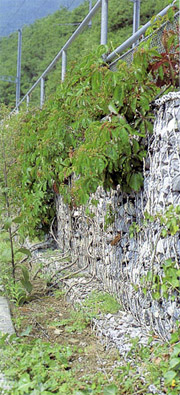 FREQUENTLY ASKED QUESTIONS FREQUENTLY ASKED QUESTIONS
1. What is a gabion retaining wall?
Steel and stone - a really creative relationship!
The earliest known use of gabion structures was about 7,000 years ago. The Egyptians used baskets woven from sedge and filled with sludge to protect the shores of the Nile in the age of the pharaohs. Later on in the Middle Ages, in Europe baskets woven from sticks were filled with stones and earth and used for building castle fortifications or for protecting the shores of rivers. Today these baskets are called gabion structures, the name derives from the Italian word gabbione meaning "big cage". In the middle of the 19th century gabion boxes were made only from woven steel wire, while welded steel mesh gabion boxes appeared in the middle of the 20th century.
So gabions are steel wire structures packed with stone on the construction site to ensure the stability of steep slopes due to their mass, while in the case of so-called soil retaining walls stability is ensured by steel and plastic meshes built in the slope in layers.
Gabion (RENO) mattresses are designed with a lower height and are first of all built as the channel lining of watercourses.
Top of the page
2. Where can gabions be used?
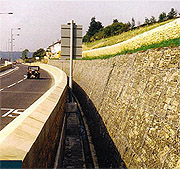 Gabion structures can be built quickly and economically under all conditions and are especially suitable for stabilising slopes in mountainous regions and in regions with unfavourable soil characteristics. GABION retaining walls are flexible, and soil movements do not result in the reduction of the load bearing capacity in the already constructed retaining wall structures, as opposed to retaining walls with a rigid concrete structure, where cracks and fractures may occur, which may result in the final deterioration of the retaining wall. Gabion structures can be built quickly and economically under all conditions and are especially suitable for stabilising slopes in mountainous regions and in regions with unfavourable soil characteristics. GABION retaining walls are flexible, and soil movements do not result in the reduction of the load bearing capacity in the already constructed retaining wall structures, as opposed to retaining walls with a rigid concrete structure, where cracks and fractures may occur, which may result in the final deterioration of the retaining wall.
Gabion retaining walls offer an economical and attractive alternative to concrete retaining walls. They can be filled with local stone or even concrete rubble.
Areas of use of gabion structures:
- Mass gravity retaining walls
- Mechanically stabilised soil retaining walls
- Supplementary elements of buildings
- Garden architectural elements (e.g. benches, partition walls, etc.)
- Channel linings
- Culverts and bridge abutments
- Gully control, water velocity reducing structures
Top of the page
3. Why are gabions used?
In the course of supporting steep slopes, aesthetical and environmental requirements must also be fulfilled besides technical requirements. Within a couple of years vegetation grows over gabion retaining walls, but selected plant species can also be planted in them in a planned way. Consequently their use offers numerous advantages as compared to other types of structures.
Their advantages:
- various possibilities of installation,
- aesthetical appearance suiting the environment,
- long life
- easy, economical and quick construction,
- materials available near the site can be used,
- permeable structure not susceptible to frost damage,
- flexibility, strength.
Gabion boxes consist of elements of various sizes, which can be attached to each other to create the desired geometry. Gabion structures overgrown with vegetation suit the natural environment. The steel mesh surface can also be supplemented with wooden cover structures.

The mesh made of steel wire coated with a metal zinc-aluminium and, perhaps, a further plastic anti-corrosion layer may last as long as 120 years. A quality certificate has been issued for the products by the British quality control authority (BBA). The quality of the filling stone material is also an important aspect in respect of lifetime. Favourably eruptive, frost-resistant rocks should be used for filling the gabion boxes.
The price of gabion structures made of steel wire is more favourable than the price of other building materials. They are delivered flat-packed, therefore the costs of delivery are not significant. Trained workers can quickly learn how to assemble and fill the structures, therefore there is no need for a skilled labour force. In many cases the structures can be constructed without using machines. Generally pile driving, draining or the use of earth excavation machines can be avoided.
Gabion structures are characterised by great water permeability, so there is no need for constructing a back-drain system, which is essential in the case of concrete structures. On areas in contact with the soil geotextile fabric with high water permeability must be put down to stop the gaps between the stones from filling up.
In the case of water courses there is unhindered communication between ground water and the water flowing in the channel, no hydrostatic pressure is borne by the structure.
Due to the load bearing capacity of the steel mesh, the structure adapts flexibly to forces occurring as a result of soil movements occurring after the construction of the gabion wall (change of volume, sinking). Consequently the box made of steel mesh is not simply a box for accommodating stones, but it also strengthens the structure. The partition chambers (diaphragms) placed vertically in the box every meter also strengthen the structure. As years pass, the stems and roots of the vegetation growing over the structure strengthen the gabion structure even more.
The cost price of the retaining wall is 25-40% lower than that of retaining walls with a concrete structure.
Top of the page
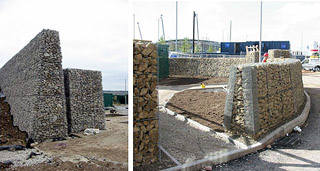 4. Welded or woven wire-mesh gabions? 4. Welded or woven wire-mesh gabions?
Choosing welded mesh gabion and its use often has more advantages as compared to woven mesh gabion.
- In the case of the welded mesh structure, when creating the planned retaining wall geometry it can be avoided to double the individual boxes on the connection side, while in the case of woven gabion boxes the doubling of the sides is unavoidable.
- Often welded mesh gabion structures have the same flexibility as woven structures, but their strength and endurance characteristics are better.
- Welded mesh gabions are more resistant to corrosion than gabions made using the woven technology.
- The size tolerance of welded mesh gabion units is 0.5%, while the size tolerance of woven mesh gabion units 5%!
- In the case of woven mesh with PVC coating the plastic coating often cracks due to twisting during manufacture, so it provides less protection against UV rays and corrosion than the coating on welded mesh.
- Welded mesh gabion boxes, when being filled with stones, are rigid and retain their shape, while gabion boxes made of woven mesh do not retain their shape so well and often become deformed when exposed to the pressure of the filling stones.
- Consequently the planned geometry and the wall face can be ensured with greater confidence in the case of welded mesh gabion structures.
- Welded mesh gabion panels can be assembled using spiral binders, which saves time.
- 20-30% less time is needed for assembling welded mesh gabion boxes.
For the description and technical data of woven mesh and welded gabions click here. »
Top of the page
|
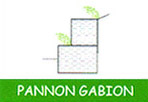
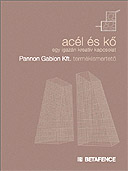
 FREQUENTLY ASKED QUESTIONS
FREQUENTLY ASKED QUESTIONS Gabion structures can be built quickly and economically under all conditions and are especially suitable for stabilising slopes in mountainous regions and in regions with unfavourable soil characteristics. GABION retaining walls are flexible, and soil movements do not result in the reduction of the load bearing capacity in the already constructed retaining wall structures, as opposed to retaining walls with a rigid concrete structure, where cracks and fractures may occur, which may result in the final deterioration of the retaining wall.
Gabion structures can be built quickly and economically under all conditions and are especially suitable for stabilising slopes in mountainous regions and in regions with unfavourable soil characteristics. GABION retaining walls are flexible, and soil movements do not result in the reduction of the load bearing capacity in the already constructed retaining wall structures, as opposed to retaining walls with a rigid concrete structure, where cracks and fractures may occur, which may result in the final deterioration of the retaining wall.
 4. Welded or woven wire-mesh gabions?
4. Welded or woven wire-mesh gabions?